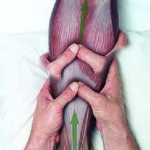Written by Alison Stickel
In the midst of the summer, many become more involved in the outdoors with cycling, hiking and more. Patients often present us with really sore and tight calf pain as a result. The calf can easily be injured due to overexertion and improper stretching before exercise.
The calf anatomy is made up of two muscles. The gastrocnemius is the largest muscle and bulge you see as your calf. The smaller and more intrinsic muscle deep below the gastrocnemius is the soleus muscle. Acute muscle strains can occur in both muscles. The larger gastrocnemius muscle is more commonly affected or injured.
Symptoms of calf muscle strains can include:
- Pain with calf stretching
- Tenderness at the muscle
- Tightness of the muscle
- Pain with exertion of the calf
- Pain with the raising the heel (especially on steps)
Treatment is necessary because overuse of the calf muscle can lead to thickening of the tissue and predisposing the calf to further injury. Overuse can also cause muscle imbalances and compensatory movement and walking patterns that can lead to other biomechanical issues.
Treatment from a physiotherapist will help reduce pain, tightness and prevent re-injury. Treatment techniques include:
- Deep and soft tissue work to release tension In the muscle
- Dry needling
- Hot and Cold Therapy
- Massage Therapy
- Tailored stretches and exercises for muscle re-strengthening



